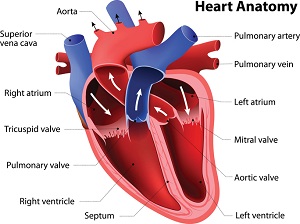In this series, we will look at how the heart works, heart diseases, and therapies.
How the heart works
Your heart is a pump. It's a muscular organ about the size of your fist, located slightly left of center in your chest. Your heart is divided into the right and the left sides.
- The right side of the heart includes the right atrium and ventricle. It collects and pumps blood to the lungs through the pulmonary arteries.
- The lungs give the blood a new supply of oxygen. The lungs also breathe out carbon dioxide, a waste product.
- The oxygen-rich blood then enters the left side of the heart, including the left atrium and ventricle.
- The left side of the heart pumps blood through the largest artery in the body (aorta) to supply tissues throughout the body with oxygen and nutrients.

Heart valves
Four heart valves keep your blood moving the right way by opening only one way and only when they need to. To work properly, the valves must be formed properly, must open all the way, and must close tightly so there's no leakage. The four valves are:
- Tricuspid(Between right atrium and ventricle)
- Mitral (Between left atrium and ventricle)
- Pulmonary (Between right ventricle and pulmonary artery)
- Aortic (Between left ventricle and Aorta)
Heartbeats
A beating heart squeezes (contracts) and relaxes in a continuous cycle.
- During contraction (systole), your ventricles squeeze tight, forcing blood into the vessels to your lungs and body.
- During relaxation (diastole), the ventricles are filled with blood coming from the upper chambers (left and right atria).
Electrical system
Your heart's electrical wiring keeps it beating. Your heartbeat controls the continuous exchange of oxygen-rich blood with oxygen-poor blood. This exchange keeps you alive.
- Electrical signals begin high in the upper right chamber (right atrium) and travel through specialized pathways to the ventricles, delivering the signal for the heart to pump.
- The system keeps your heart beating in a coordinated and normal rhythm, which keeps blood flowing.
Coronary Artery
- As mentioned earlier, the heart is a muscle. It needs oxygen (blood) to function. The coronary artery provides blood to the heart.